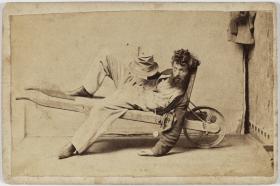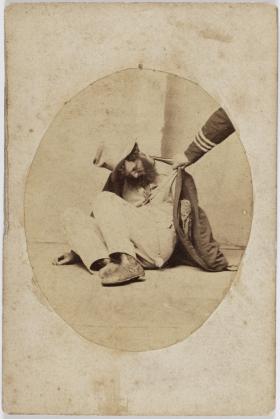The five stages of inebriation
Key inquiry question #1
The Five Stages of Inebriation: Charles Percy Pickering (between 1863-1868).
Text Type
- Persuasive: Students compose captions for photographs
- Persuasive: Students stage a tableau vivant consisting of five scenes intended to persuade young adults to change their attitudes or behaviour
Learning intention
Students are learning to:
- Use persuasive language
- Respond to visual stimulus
- Work collaboratively
- Develop a performance piece
Success criteria
Students will be successful when they can:
- Create a persuasive pamphlet
- Work effectively as a group
- Develop a Tableau Vivant in order to persuade an audience
Background notes for teachers
The Five Stages of Inebriation is a set of photographs that illustrate the effects of drunkenness in five stages. A male actor plays the role of the drunken man.
The five photographs date from between 1863 and 1868.
It is likely that the photographs were taken by Charles Percy Pickering in his Sydney photographic studio. They were taken in the time before most people had cameras in their homes and so visited a studio to have their portrait taken.
The photographs were purchased by the State Library in 2007. The State Library of New South Wales believes the photographs may have been commissioned by a local temperance group to educate people about the dangers of drinking alcohol. The photographs may have also been used to by an illustrator to produce engravings for posters.
Temperance societies were groups who opposed the drinking of all alcoholic drinks, such as wine, beer or spirits. They encouraged people to be “teetotallers”, those who do not drink any alcohol at all. The term teetotaller emerged because English temperance campaigner John Turner had a speech defect called a stutter. In a speech he was heard to argue that: “N-n-nothing but t-t-t-total abstinence will do.”
Temperance societies encouraged governments to pass laws that banned alcohol or limited its availability. They were active in Australia.
In the 1880s a number of hotels were built as or converted to coffee palaces. You can see a photograph of a coffee palace in Sydney called Temperance Hall in our catalogue.
During World War I in Australia the federal government passed laws that meant pubs could not sell alcohol after 6:00 pm. This led to the “six o’clock swill”, where men would try to drink as much as they could in the short time between work hours concluding at 5:00 pm and the official pub closing time. Six o’clock closing did not end until 1967.
Did you know?
The Five Stages of Inebriation are albumen print photographs. Until the turn of the twentieth century almost all photographs were printed on paper made using egg whites!
Albumen print photography was invented by Frenchman Louis-Desiré Blanquart-Evrard in 1850. This process was most popular in the 1850s to 1860s, when Australian photographer Charles Percy Pickering produced The Five Stages of Inebriation. Albumen print photography was used in Australia until the 1920s.
Albumen comes from the white liquid part of an egg. It was collected by beating egg whites and a type of salt. In 1866 The British journal Quarterly Review estimated that six million hen eggs were used annually in England to supply the albumen for coating paper.
Albumen prints, or albumen silver prints, were the first commercial method of producing a photographic print on a paper base from a film negative. The albumen in egg whites was used to bind photographic chemicals to the surface of the paper. They gave a more detailed image than just painting photographic chemicals on to the paper.
The process of making albumen photographic paper firstly involved painting pieces of paper with albumen and then with silver nitrate, a chemical that makes the paper sensitive to ultraviolet light. This was a very time consuming process as it could take three to six months for the paper to dry before it was ready to use.
After being dried the paper would be placed in contact with a glass plate negative and then exposed to sunlight or ultra violet light. Once the print was dark enough it would then be dipped in a fixative to stop it reacting to light. Albumen photographic paper had a short shelf life and needed to be used within three months of being made.
Albumen prints are easily recognised by the warm brown colour of the background and the yellow and cream colour of the highlights. They provide excellent detail and a warm glossy appearance to the photograph.
The State Library of New South Wales, like any collector of albumen photographs, takes care to preserve them by keeping them dry and cool. Exposure to light is kept to a minimum and they are never left on display for very long. Paper photographs can be affected by mould if they become damp.
Student Activities
Temperance Society Pamphlet
Students write captions for The Five Stages of Inebriation images, suitable for use in a temperance society pamphlet.

Five Stages as a tableau vivant
Students design a tableau vivant consisting of five scenes that warn a young adult audience against the dangers over time of a particular behaviour, and present their tableau vivant to the class.

Additional Resources
Temperance Hall, Pitt St., Sydney, Nov 1870, State Library of NSW
NSW Syllabus for the Australian Curriculum: English K-10
A student:
- responds to and composes increasingly sophisticated and sustained texts for understanding, interpretation, critical analysis, imaginative expression and pleasure EN5-1A
- selects and uses language forms, features and structures of texts appropriate to a range of purposes, audiences and contexts, describing and explaining their effects on meaning EN5-3B
- thinks imaginatively, creatively, interpretively and critically about information and increasingly complex ideas and arguments to respond to and compose texts in a range of context EN5-5C
- understands and evaluates the diverse ways texts can represent personal and public worlds EN5-7D
Students:
EN5-1A
Respond to and compose texts
- create sustained texts, including texts that combine specific digital or media content, for imaginative, informative, or persuasive purposes that reflect upon challenging and complex issues (ACELY1746, ACELY1756)
EN5-3B
Respond to and compose texts
- compose and respond to a wide range of visual texts, e.g. picture books, graphic novels and films, using a range of appropriate techniques and metalanguage
EN5-5C
Respond to and compose texts
- respond to and compose a range of sustained imaginative, informative and persuasive texts which are increasingly demanding in terms of ideas, arguments and linguistic, structural, cognitive, emotional and moral complexity
EN5-7D
Respond to and compose texts
- respond to and compose sustained imaginative, creative and critical texts that represent aspects of their expanding personal and public worlds, for a wide range of purposes, including for enjoyment and pleasure
In each year of Stage 5 students must study examples of:
- visual texts
- media, multimedia and digital texts
Across the stage, the selection must give student experience of:
- a wide range of cultural, social and gender perspectives, popular and youth cultures
Learning across the curriculum
General Capabilities:
- creative and critical thinking
- literacy
- information and communication capability
- personal and social capability
Areas for important learning:
- civics and citizenship